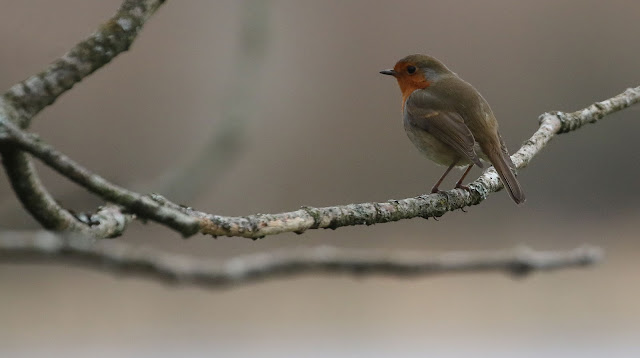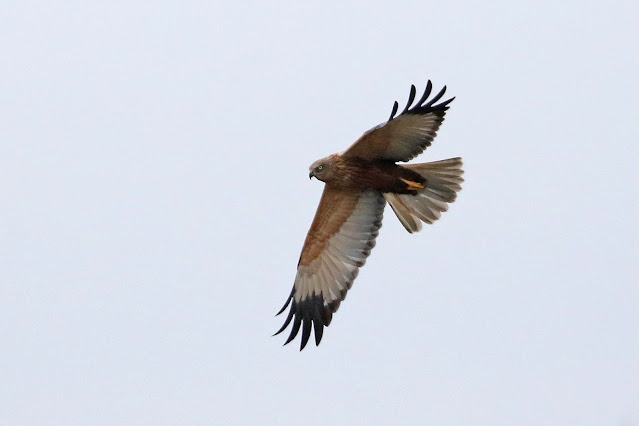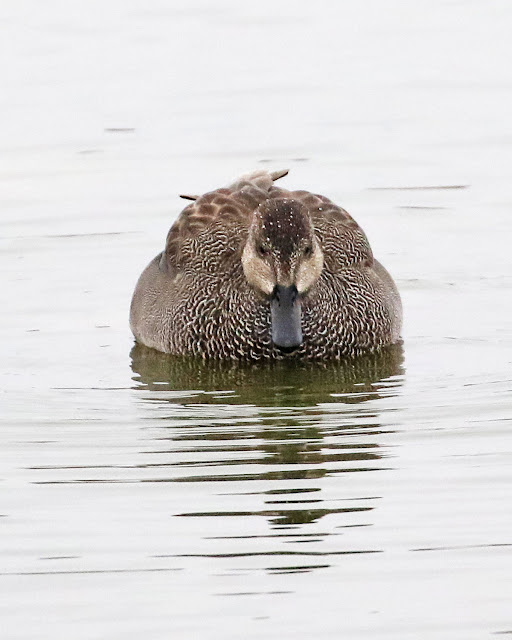After the clear, cold mornings that were present through the week, my journey to Hill Head this morning was in temperatures just above freezing, with a thick cloud cover and absolutely no wind. Arriving at the sea wall just after sun rise it was gloomy with the tide well out and a still calm sea.
As I kitted up to face the weather I noticed the Sanderling feeding along the tide line below me, as they were a year tick once sorted out I walked across the beach and got down low to get just a few more images. The challenge though was to get something a little different, this challenge didn't start too well though.
But then I thought, how about black and white, the conditions were gloomy and the images at a very high ISO, so I have converted these:
As the Sanderling feed there are groups that have there own Black-headed Gull "minder". The gulls stay close and wait for the waders to pull up something of significant interest and then move in to take it. The gulls also appear to call to each other as if discussing which group has the best chance of a meal.
Finally a couple of shots with some colour.
Leaving the beach I walked around to the corner of the harbour and scanned the sea, a group of 23 Eider were offshore and quite close for once. I could just make out their calls as the drakes displayed to the females.
The sea though, further out, was dominated by Great-crested Grebes, as I scanned from east to west I counted 164, but there could well have been more as many were diving intermittently. Whilst scanning through the many grebes I picked up two waders heading east mid channel, I managed to get the scope on them because my first thought was curlew which are not that common here, but they were in fact Bar-tailed Godwits. I watched them as they carried on and away past Lee.
Walking back to the car the water level in Duck Bay was low and there was mud exposed at the base of the reeds. I scanned along the base and found what I was looking for a Water Rail.
I decided to walk up to the first viewing point on the cliffs just past the chalets, with the sea so calm it would be easier to pick things out from up there. Scanning around there were more Great-crested Grebes and a large distant group of Eider. Once again the gulls were playing minders and it was down to the gulls that I managed to locate the four Velvet Scoters. With the sea so still it was possible to zoom right to the extent of the scope and get some great views, being able to make out the white markings at the bottom and back of the eye in the drake, while the females have more of a smudge behind the eye. But of course there was also the obligatory wing flap to show the white wing panel. Here is the best record shot I could get of two of the duck.
Easier to identify were three Eider that came past before heading into Southampton Water.
The tide was now rising but it was still extremely calm and still.
I continued to scan back and forth and eventually found something different a very distant Red-throated Diver. I felt it would be an idea to go back to the car to see if it was closer from the sea wall, but once I got there I couldn't locate it. I did however pick up a Sandwich Tern, at first around the harbour mouth and then just off the disappearing Rainbow Bar.
From the car I decided to walk the Canal Path, it has been a while since I have walked it. At the start though I remembered why it is sometimes best to avoid it in winter. The mud was quite heavy in places and with even boots on you feel like you are taking one step forward and two backwards.
I could see a raptor in a tree at the back of the fields and dismissed it as a Buzzard as it was pretty much in the centre of the tree. But as I walked on I picked up a male Marsh Harrier, and no bird in the tree.
There were several Chiffchaff calling from the trees alongside the canal. I finally managed to see one though as it was fly catching from the reeds.
At Posbrook Floods there were Shoveler, Wigeon, Teal and Pintail, but most were scattered around the edge of the floods with mostly Coot in the open water.
Robins appeared to be pairing up with pairs being seen tolerating each other on the fence. I liked the background with this Robin.
It had to be done, I walked to the view point for the Barn Owl and there it was sitting nicely in the opening. This gives an idea of how open the tree appears at this time of year.
Then a closer view, this time in black and white because I have many of these views, I need something different.
It will be a sad day when this easy year tick isn't there any more.
Job done, I made my way back. As well as the Robins showing some sign of Spring, the Great Tits too were very vocal, probably in part due to the rise in temperature today as well as the thoughts of spring.
A little further a Kestrel was sitting at the top of a tree and watch the field intently
With lunch approaching I decided to spend the rest of the day on the reserve, my walk to the visitor centre to check was interrupted when I checked the beach behind the harbour and saw that there was a sizeable Sanderling roost, well who could resist.
I walked down to the water's edge and managed to view across the groyne, with a nice black groyne on the other side as a background.
I think that is enough for today.
Stopping off at the bridge a Little Grebe was diving directly below the bridge.
I decided to walk all the way to the furthest hide on the west side, the Spurgin Hide. There had been recent reports of a Siberian Chiffchaff, plus good views of Cetti's Warblers and of all the choices available this seemed the best option to start. Arriving in the hide I settled down with lunch to wait it out. In front of me the water was empty and all that was to be seen were a pair of Stonechat in the recently cut strip of reeds.
Eventually the Stonechat couple found themselves to the left of the hide amongst the reed mace. Here the female.
As the female Stonechat was dropping to the ground from the reeds a Cetti's Warbler appeared in the reeds.




































































No comments:
Post a Comment